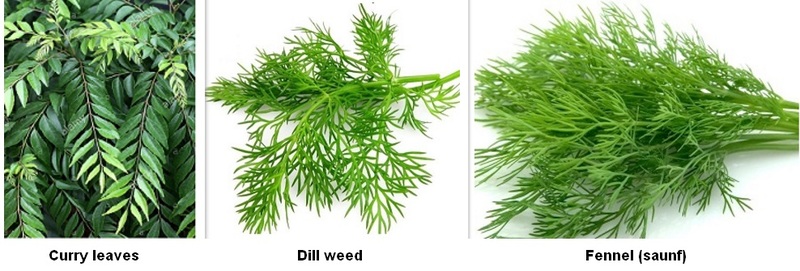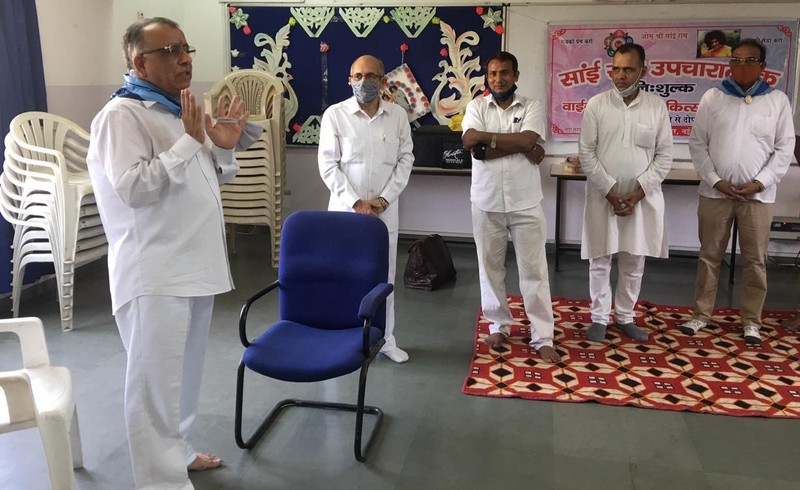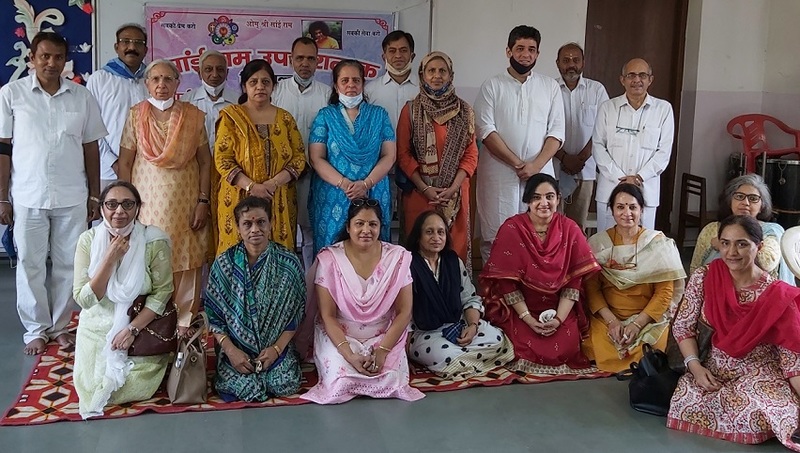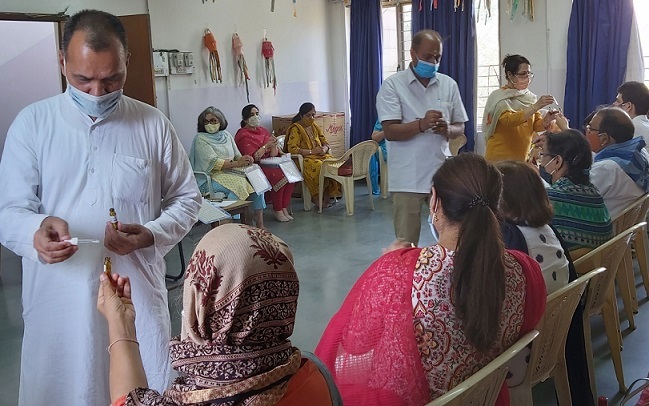In Addition
Vol 12 अंक 3
May / June 2021
Health tips
Herbs for flavouring and enriching your food for wellbeing
“Under the skin lies a very light secondary layer. It is this layer that protects the skin. Green leaves strengthen this layer, apart from having other benefits.”…Sathya Sai Baba1
1. What are herbs?
Herbs are leafy greens or flowering parts of a plant including their tender stems. There are myriads of herbs; some are ideal for flavouring food, some used as vegetables, some essentially medicinal, and some used for beauty treatment, or as perfumes or disinfectants. In this article, we present health-enhancing edible herbal leaves. Milder than spices, herbs are used in small quantity to impart flavour, brightness, and colour to dishes.2-4
2. Benefits, usage, and storage of herbs
Benefits: Herbs are a good source of essential vitamins, minerals, and antioxidants to enhance health and prevent disease, aid digestion, give relief from colds and reduce aches and pains.4-5 Flavour of fresh herbs can also serve to replace or at least reduce intake of sugar and salt.5
Usage: Chop the soft and tender herb gently by hand, and add it to the dish at the end of cooking or at the time of serving. Add dried herbs at the beginning or during the cooking process. As one teaspoon of dried herbs equals four teaspoons of fresh ones, start with a pinch to know its strength to ensure that the taste or aroma of the main ingredient in a dish is not masked.6,7
Storage: Fresh herbs will last longer if they are washed gently, dried carefully, wrapped in a paper towel and stored in a resealable bag in the refrigerator. Store very tender herbs like basil and dill in water at room temperature. Change the water every couple of days and discard wilted stems. Store dried herbs in air-tight plastic bags, glass jars, or stainless steel containers in a cool, dark, and dry place, preferably freeze or refrigerate. They may last for a year or more. Dry bay leaves last up to 2 years. Check their freshness once in 3-4 months by crushing a small amount and sniffing; the aroma should be fresh.6,8,9
We are covering 20 commonly used herbs. Their Indian names, wherever applicable, are given in parenthesis.
3. Flavouring herbs
3.1 Basil & Holy basil (Tulsi): There are many types of basil with different flavours. Sweet basil leaves used in sauces (especially Italian pesto), salads, soups, and as a topping on pizza have a  warm spicy flavour. Widely researched “tulsi”, with light green or purple leaves with tooth-like edges and strong peppery flavour, has powerful healing qualities. Its concoction can help prevent lifestyle diseases, assist in normalising blood sugar and blood pressure, enhance immunity, and relieve cold and flu as well as anxiety and depression.10-13
warm spicy flavour. Widely researched “tulsi”, with light green or purple leaves with tooth-like edges and strong peppery flavour, has powerful healing qualities. Its concoction can help prevent lifestyle diseases, assist in normalising blood sugar and blood pressure, enhance immunity, and relieve cold and flu as well as anxiety and depression.10-13
3.2 Bay leaf (Tej patta): Most aromatic of all the herbs, whole bay leaves are added during cooking and removed before serving; used in stews for relief from sinusitis. Its regular intake in powdered form or in a capsule may increase nutrient absorption, reduce the risk of diabetes and heart disease, and prevent stomach ulcers.14-16
3.3 Celery (Ajmod): A traditional herb with a strong aromatic flavour, its leaves are ideal for garnishing salads, soups, and noodles, and stalks are eaten raw or cooked as a vegetable. It is a natural detoxifier and prevents bacterial infections.17
3.4 Chives: This herb goes well with salads and vegetable dishes, as a topping especially on baked potatoes. A good source of vitamins A, C, K, choline, folate, and fibre, it may lower the risk of  stomach cancer, heal sunburns and sore throat, lower blood pressure, help body metabolism and foetal development, act as a mild stimulant and diuretic, and is a natural bug repellent. Don’t cut chives unless ready to use them. They can be dried and frozen and stored for years.18,19
stomach cancer, heal sunburns and sore throat, lower blood pressure, help body metabolism and foetal development, act as a mild stimulant and diuretic, and is a natural bug repellent. Don’t cut chives unless ready to use them. They can be dried and frozen and stored for years.18,19
3.5 Cilantro/Coriander (Hara dhania): Cilantro refers to the fresh leaves of the coriander plant. The leaves along with the tender portion of the stem lend a nice flavour to salads, soups, and other dishes. A good source of vitamins A,C, and K, it can aid in digestion, detoxify the body, soothe skin irritation, lower anxiety and improve sleep, promote healthy vision, and strengthen the skeletal system.4,20,21 (also see vol 11 #3 ).
Culantro/long coriander: Often confused with cilantro, it is an unusual herb with long serrated leaves and stronger aroma; mostly available in dried form.4
3.6 Curry leaves (Kadi patta): These amazing leaves of the curry tree (grown in many Indian households) are an essential ingredient in cooking in India and Srilanka. They can reduce blood sugar  and cholesterol and prevent infections and anaemia. One can chew fresh leaves to detoxify the body, to enhance digestion, and to prevent hair fall.22-24
and cholesterol and prevent infections and anaemia. One can chew fresh leaves to detoxify the body, to enhance digestion, and to prevent hair fall.22-24
3.7 Dill weed (Suva bhaji): Fernlike spring herb used in pickles and for garnishing many dishes, snacks, and salads; sometimes used like a vegetable in large quantity, sautéed with potatoes. It can boost digestion, combat infections, regulate diabetes, enhance calcium absorption, and give relief from menstrual cramps and insomnia. It does not stay fresh for more than a day.25-27
3.8 Fennel (Saunf ke patte): Similar to dill in looks and flavour, it is a totally edible herb. Its juice helps in digestion and can treat urinary infections, body pain and fever, insomnia, and depression.28 (also see vol 11 #3)
3.9 Mint (Pudina): Mint imparts a fresh, aromatic, sweet and spicy flavour to drinking water, beverages, syrups, ice creams, and candies. It helps in digestion and treating intestinal worms, colic  pain, and chest congestion, boosting brain function, and balancing hormone level. It is used in cosmetics, toothpastes, and mouth fresheners. There are many varieties of mint, two commonly known are: spearmint (generally used in cooking and in chewing gum), and peppermint which may increase alertness and memory.29-31
pain, and chest congestion, boosting brain function, and balancing hormone level. It is used in cosmetics, toothpastes, and mouth fresheners. There are many varieties of mint, two commonly known are: spearmint (generally used in cooking and in chewing gum), and peppermint which may increase alertness and memory.29-31
3.10 Oregano: It is sprinkled on pizza, pasta, salads, soups and sauces for flavour. It is used to treat an upset stomach, respiratory issues, inflammation, and infections. Oregano tea is good for gut health, sore throat and cough.32-35
Marjoram: Similar but milder and sweeter than oregano.35
3.11 Parsley: Similar to cilantro in appearance, use, and benefits, parsley has pointed serrated leaves with bitter taste. It has a delicate flavour which gets enhanced if mixed with cilantro. A natural breath freshener and diuretic, parsley has vitamin B, in addition to vitamins A, C, & K. It can boost immunity and kidney health, protect eyes, skin, heart, and bones, and reduce acidity and bloating.4,36-38
French Parsley/chervil: Similar but a more delicate annual herb.4
3.12 Rosemary (Gulmehendi): A herb of the mint family, with needle-like leaves, it is used to flavour a dish at the end of cooking and to make tea. Rosemary can boost the immune system and  memory, reduce stress and drowsiness, impart calmness, aid digestion, and act as an insect repellent. Often used in making candles, perfumes, and cosmetics.39-41
memory, reduce stress and drowsiness, impart calmness, aid digestion, and act as an insect repellent. Often used in making candles, perfumes, and cosmetics.39-41
3.13 Sage: A powerful woody herb with hair-like structures on its leaves, sage is closely related to rosemary. Apart from flavouring foods, it is ideal for infusing into herbal tea and other beverages. Traditionally it is used to treat infections, pain, mouth ulcers, and memory problems, it is a natural cleanser and air purifier. In ancient times it was used to ward off evil and treat snakebites.4,42,43
3.14 Savory: Winter savory is a delicious herb that can add minty flavour to any recipe. The aromatic summer savory with a peppery flavour is a good substitute for parsley; can be had raw in salads or cooked, especially with beans. Both types of savory are nutritive and help to give relief from muscle pain, bronchial congestion, digestive problems, and bites and stings, and fight infections.44-47
3.15 Tarragon: Tasty when consumed raw, it can provide relief from toothache and suppressed menstruation, fight bacteria, and improve digestion and sleep. Tarragon tea can reduce stress and  anxiety.4,48
anxiety.4,48
3.16 Thyme: Considered a cousin of oregano, it is earthy, lemony, and minty, and would impart better flavour when used together with rosemary. It has more vitamin A & C than oregano, is a natural diuretic, can stimulate appetite, alleviate digestive and respiratory problems, and fight infections. It can get rid of pests. In ancient times It was effectively used to prevent and treat poisoning.4,49,50
4. Herbal leaves used more like vegetables
4.1 Amaranth leaves (Chaulai): Superior to most greens, it is very rich in vitamins A, C, B-complex, and K and iron. It contains more potassium and a lot more calcium than spinach. It prevents  osteoporosis and iron deficiency anaemia. Fresh tender leaves could be mixed with salads, or made into juice or paste or curry and also cooked with lentils.51-53
osteoporosis and iron deficiency anaemia. Fresh tender leaves could be mixed with salads, or made into juice or paste or curry and also cooked with lentils.51-53
4.2 Fenugreek leaves (Methi): It is commonly used in wheat bread (chapatis) or cooked as a vegetable, especially with potato, its regular consumption can prevent and treat anaemia, all kinds of digestive issues, and diseases like beriberi and tuberculosis, control glucose level, and stabilise body temperature. Made into a paste, it can remove scars and stop baldness; mixed with lemon juice, it can be a natural mouthwash.54 (also see vol 11 #3 & #5)
4.3 Moringa/Drumstick leaves (Sahajan): Most potent part of the miracle plant, moringa leaves have more than 90 nutrients, 46 different antioxidants, and all the essential amino acids making it protein-rich, twice as much calcium as in milk, and three times the iron in spinach. The leaves are used in breads, dosas, made into a paste, or sautéed with vegetables for their flavour and nutritional value. These can enhance immunity, balance blood sugar, and are excellent for the digestive system. Moringa seeds when put in dirty water will attract the impurities and make the water drinkable.55-57 (also see vol 11 #5)
4.4 Sorrel leaves/Sour spinach (Pitwaa/Gongura): it is the only leaf that can be eaten in the monsoon without fear of contamination. It has a tangy flavour and gains sourness with temperature. Normally consumed as chutney, it is also used in pickles, and cooked with vegetables or lentils. Being nutrition-rich, it can prevent many diseases including anaemia.58-60
5. Hybrid of herbs
5.1 Herbs de Provence: Commonly used in French cuisine, it is an aromatic mixture of dried herbs - basil, bay leaf, marjoram, oregano, rosemary, savory, tarragon, and thyme.61
5.2 Tisane/Herbal tea: Tea from herbs can be very rejuvenating. Take any herb of choice and let it remain in hot water for 2-3 minutes or more, strain and sip. This way one gets all the benefits of that plant in a form that is easy to digest. Apart from oregano, rosemary, sage, tarragon, thyme, and tulsi, one can make tea from eucalyptus leaves, echinacea, hibiscus (antiviral), fennel, lemongrass, mint, celery and rooibos (for detoxification, good digestion, and boosting immunity), or chamomile and passionflower (for their calming effects).62-66
6. Conclusion
All herbs make food appetising, refreshing and are safe and healthy in small amounts for flavouring. Moderation is the key even when using herbs as vegetables. However, people having allergies, on blood thinners or medications for lifestyle or life-threatening diseases, or pregnant women should be cautious about specific herbs and their quantity.
References and Links
- Food for a healthy body and mind, Divine Discourse at the Sri Sathya Sai Institute of Higher learning, July 1996, https://static.ssssoindia.org/wp_uploads/2018/03/26172212/Preventive-Health-Care-Module.pdf, page 15.
- What is a herb: http://www.differencebetween.net/science/health/difference-between-plants-and-herbs/
- Herb milder than spice: https://www.britannica.com/story/whats-the-difference-between-an-herb-and-a-spice
- Various benefits of herbs: https://www.homestratosphere.com/types-of-herbs/
- Beneficial herbs: https://www.mdlinx.com/article/10-nutritious-herbs-you-should-add-to-your-diet-now/lfc-3732
- Usage and Storage of herbs: https://www.thespruceeats.com/what-are-herbs-995714
- https://www.thespruceeats.com/how-to-substitute-dried-herbs-for-fresh-herbs-1388887
- Storing fresh herbs: https://www.goodhousekeeping.com/home/gardening/a33670791/how-to-store-fresh-herbs/;
- https://www.thekitchn.com/your-guide-to-storing-fresh-herbs-in-the-fridge-231412
- Basil varieties, use, benefits: https://www.thespruceeats.com/what-is-basil--1807985;
- https://www.medicalnewstoday.com/articles/266425#benefits
- Holy basil/tulsi Research-backed efficacy: https://www.ncbi.nlm.nih.gov/pmc/articles/PMC5376420/;
- https://draxe.com/nutrition/benefits-of-basil/
- Bay leaves: https://www.everydayhealth.com/diet-nutrition-pictures/healthy-herbs-and-how-to-use-them.aspx;
- https://www.thespruceeats.com/what-is-a-bay-leaf-995576;
- https://draxe.com/nutrition/bay-leaf/
- Celery: https://draxe.com/nutrition/benefits-of-celery/
- Chives: https://draxe.com/nutrition/what-are-chives/;
- https://draxe.com/nutrition/what-are-chives/
- Cilantro/Coriander: https://draxe.com/nutrition/coriander;
- Benefits of coriander leaves: https://www.netmeds.com/health-library/post/coriander-leaves-5-excellent-health-benefits-of-adding-these-aromatic-leaves-to-your-daily-diet
- Curry leaves: https://www.netmeds.com/health-library/post/curry-leaves-medicinal-uses-therapeutic-benefits-for-hair-diabetes-and-supplements;
- https://draxe.com/nutrition/top-herbs-spices-healing/;
- https://indianexpress.com/article/lifestyle/health/chew-curry-leaves-ayurveda-diet-health-benefits-6559838/
- Dill leaves: https://www.netmeds.com/health-library/post/dill-leaves-astonishing-benefits-of-adding-this-nutritious-herb-to-your-diet;
- https://draxe.com/nutrition/top-herbs-spices-healing/;
- https://www.tarladalal.com/glossary-dill-leaves-shepu-suva-bhaji-376i
- Fennel leaves: https://www.1mg.com/hi/patanjali/saunf-benefits-fennel-in-hindi/
- Mint: https://www.netmeds.com/health-library/post/pudinamint-leaves-health-benefits-of-pudina-juice-uses-for-skin-hair-and-side-effects;
- https://www.webmd.com/diet/health-benefits-mint-leaves#1;
- https://draxe.com/nutrition/mint-leaves/
- Oregano: https://www.webmd.com/vitamins/ai/ingredientmono-644/oregano;
- https://draxe.com/nutrition/oregano-benefits/;
- https://www.thespruceeats.com/greek-oregano-tea-1705058
- Oregano & Marjoram: https://www.masterclass.com/articles/whats-the-difference-between-oregano-and-marjoram
- Parsley: https://draxe.com/nutrition/parsley-benefits/;
- Parsley vs Cilantro: https://www.wellandgood.com/cilantro-vs-parsley/
- Parsley vs coriander: https://economictimes.indiatimes.com/parsley-versus-coriander-a-dichotomy-of-cultural differences/articleshow/25002244.cms?from=mdr
- Rosemary: https://draxe.com/nutrition/rosemary-benefits/;
- https://www.verywellmind.com/does-rosemary-actually-improve-your-memory-4156875;
- https://www.flushinghospital.org/newsletter/the-health-benefits-of-rosemary/
- Sage: https://draxe.com/nutrition/sage-benefits/;
- https://www.netmeds.com/health-library/post/sage-5-stunning-health-benefits-of-the-memory-boosting-herb
- Savory: https://www.homestratosphere.com/types-of-herbs/#Winter_Savory;
- https://www.healthbenefitstimes.com/summer-savory/;
- https://www.masterclass.com/articles/what-is-savory-herb-learn-about-winter-and-summer-savory-with-4-recipe-ideas;
- https://www.ncbi.nlm.nih.gov/pmc/articles/PMC4142450/
- Tarragon: https://draxe.com/nutrition/tarragon/
- Thyme: https://draxe.com/nutrition/thyme/;
- https://www.healthline.com/health/health-benefits-of-thyme
- Amaranth leaves: https://www.nutrition-and-you.com/amaranth-greens.html;
- https://pharmeasy.in/blog/16-health-benefits-and-nutritional-value-of-amaranth-leaves/;
- https://www.researchgate.net/figure/Nutrients-comparison-of-vegetable-amaranth-with-spinach-and-other-leafy-vegetables-per_tbl4_232276940
- Fenugreek leaves: https://stylesatlife.com/articles/fenugreek-leaves-benefits/
- Moringa: https://draxe.nutrition/moringa-benefits/;
- https://www.vanguardngr.com/2013/06/the-many-unknown-benefits-of-moringa-leaf/;
- https://www.banyanbotanicals.com/info/blog-the-banyan-insight/details/moringa-oleifera-ayurveda-superfood/
- Sorrel leaves/Sour spinach: https://www.thehindu.com/life-and-style/food/go-for-the-gongura/article19125502.ece
- https://www.livemint.com/mint-lounge/features/gongura-an-ancient-leaf-for-all-seasons-1552045899317.html;
- https://medhyaherbals.com/gongura-roselle-ambadi/
- Herbs de Provence: https://www.masterclass.com/articles/what-are-herbs-de-provence
- Tisane/Herbal tea: https://www.healthline.com/nutrition/10-herbal-teas;
- https://www.healthline.com/nutrition/tea-for-digestion#TOC_TITLE_HDR_3;
- https://www.verywellfit.com/eucalyptus-tea-benefits-and-side-effects-4163892;
- https://completewellbeing.com/article/herbal-tea-drink-wellbeing/;
- https://www.healthline.com/health/anxiety/tea-for-anxiety
2. Update on Covid-19 remedy
The dire shortage of oxygen for Covid-19 patients in India spurred the research team to look into ways of increasing the oxygen saturation level. The findings confirm that remedy made in water using card SR304 Oxygen at 200C and given every ten minutes can quickly boost the oxygen level to around 90. The dosage can then be tapered down slowly as the improvement progresses and the level can reach up to 95 within 2 days. Practitioners with only 108CC box can instead use CC19.1 Chest tonic with the same dosage as above. Remember to continue the IB remedy as per guidelines in vol 12 #2.
In view of the above finding, the IB remedy prepared using the SRHVP has been modified to: BR4 Fear + BR9 Digestion + SM26 Immunity + SM27 Infection + SM31 Lung & Chest + SM40 Throat + SR272 Arsen Alb 30C + SR277 Bryonia 30C + SR291 Gelsemium 30C + SR304 Oxygen 200C. Remedy prepared using the 108CC box remains the same, refer to vol 12 #2, In Addition section #2. You may also like to refresh your memory with the miraculous experience of practitioner 11601…India with the oxygen card, see vol 11 #6, section #2. She has further reported great success with patients who were on oxygen in the hospital as well as at home, on using SR304 at 200C.
IB used as nasal drops:
The practitioner 11626 having an allergy to strong smell and dust, developed sneezing, so increased the IB dosage to 6TD (was taking preventive at OD). Sneezing was gone in two days but she still had blocked nose and headache. She learnt from another practitioner 11623 that IB, when made in water and used as nasal drops, immediately clears nose block. When she put one drop in each nostril, the relief was instant and phlegm started flowing. She used the nasal drops at BD and within two days her sinusitis cleared completely. Ever since she has been successfully using this for her children whenever they have blocked nose.
3. Inauguration of Vibrionics Clinic at the Sai International Centre New Delhi, 4 April 2021
With Swami’s immense blessings Sai Vibrionics reached yet another milestone on 4 April 2021 with the inauguration of a weekly Vibrionics Clinic at the Sri Sathya Sai International Centre, the abode of Swami in New Delhi. The occasion was graced by the State President of Delhi-NCR and in attendance were office bearers of SSSSO and Vibrionics team of the Delhi-NCR region.

The programme started with Veda chanting and lighting the lamp. The state president lauded the good work done by the vibrionics team in the region, assuring them of full support by the organization. He called upon them to continue serving with Love and follow the path shown by Swami. The event was concluded with a charging session of 108CC boxes of 22 practitioners.

The clinic functions on Sundays, manned by two practitioners on a rota basis and supported by a team of well-trained seva dals who also take down the vitals like BP, pulse rate and blood sugar of each patient. The relentless efforts of practitioners 11573&11437 in establishing this clinic are greatly appreciated.
4. Inspiring anecdotes
4.1 Pure love keeps flowing
A Sai student, due to classes being online, is currently in Delhi with his mother. Both had Covid-19 symptoms for two weeks and the mother was almost bedridden. He felt certain that they were both positive but the results of their test were inordinately delayed. They were struggling to have cooked food as none of their close relatives living nearby even cared to bring them some. On 23 April 2021, in desperation, he sent a message to the All India Vibrionics Coordinator who contacted a local practitioner 11389 and within minutes she personally delivered the remedies along with non-prescription allopathic medicines. She was not stopped anywhere on the way despite Delhi being under a curfew!! Swami also took care of the food when the local seva organisation started providing home-cooked food to them under an initiative started for home quarantined families in the area. The duo was left speechless, overwhelmed by the sudden outpouring of love from every quarter. From the third day, the boy started attending online classes and the mother was able to walk around and was even ready to start her work on the fifth day. The student writes: “We at Parthi who have never seen Swami are always told, He comes to you in various forms in multitudes of ways because He loves you. Today what I have received is surely medicine but I would like to call it 'pure love', the kind which Swami has for all of us. I thank Swami for coming in your form in this time which I would doubtlessly call the toughest days I have ever faced in my life. Sai Ram”
4.2 Swami’s blessings continue
On 19 April 2021, practitioner 10741 discovered that the dropper bottle containing CC3.7 Circulation in her box had completely dried up. On her request, a fellow practitioner brought to her CC3.7 in a small vial, the same afternoon. When she was ready to replenish her empty bottle she was flabbergasted to see that it was already ¾ full, with just enough room to add the liquid remedy brought to her. It was indeed the same combo bottle that Swami had physically taken out when He blessed the Master box on 2 March 2008 (refer to the picture on the first page of 108CC book). Swami’s reassurance to all practitioners!
5. Workshops & Seminars
5.1 Virtual AVP workshop, 9 Jan to 6 Mar 2021; practical workshop, Puttaparthi, 13-14 March 2021
This nine-week workshop had 36 virtual sessions covering in-depth all the nine chapters of the AVP manual which the candidates had already studied in their eCourse. Taking advantage of the  virtual platform many existing practitioners were able to attend these sessions as silent participants. This helped them to refresh and further their understanding of vibrionics. Additionally, some senior practitioners aspiring to be vibrionics teachers were given the opportunity to take up some of the topics. Guidance was given on writing case histories which is crucial to the growth of vibrionics, also there were talks on the importance of a healthy lifestyle in the prevention of disease. IASVP wing director made a presentation (see pic) on the current administrative structure of vibrionics, this was much appreciated. Dr Aggarwal in his address to the participants stressed that devotion, dedication and gratitude were essential in bringing about a cure and manifesting love can trigger healing for a patient. Practitioners should merely do their best and leave the results to Swami. This virtual workshop was a great success with 61 participants from around the globe on the final day. During the practical workshop at Puttaparthi, the newly qualified candidates took the oath and received the 108CC box with gratitude and a resolve to do their utmost to serve their patients.
virtual platform many existing practitioners were able to attend these sessions as silent participants. This helped them to refresh and further their understanding of vibrionics. Additionally, some senior practitioners aspiring to be vibrionics teachers were given the opportunity to take up some of the topics. Guidance was given on writing case histories which is crucial to the growth of vibrionics, also there were talks on the importance of a healthy lifestyle in the prevention of disease. IASVP wing director made a presentation (see pic) on the current administrative structure of vibrionics, this was much appreciated. Dr Aggarwal in his address to the participants stressed that devotion, dedication and gratitude were essential in bringing about a cure and manifesting love can trigger healing for a patient. Practitioners should merely do their best and leave the results to Swami. This virtual workshop was a great success with 61 participants from around the globe on the final day. During the practical workshop at Puttaparthi, the newly qualified candidates took the oath and received the 108CC box with gratitude and a resolve to do their utmost to serve their patients.
5.2 Virtual SVP workshop, Puttaparthi, 22-23 March 2021
The two-day seminar was conducted as a follow-up workshop for nine SVPs who had qualified during 2018-19 out of which seven attended along with five other senior practitioners. On the first day, there was an open and in-depth discussion on several case histories. The second day was fully devoted to the concepts and practices of dealing with miasms and broadcasting of remedies with valuable inputs from Dr Aggarwal.

6. In Memoriam
We bid farewell to an experienced, greatly valued practitioner Mrs Kamlesh Wadhwa 00535 who passed away at her home in London on 22 Jan 2021, at the age of 84. She was actively serving her patients until last year when her failing health due to haemolytic anaemia made it difficult for her to continue this seva. Our hearts go out to her family in their time of bereavement.

